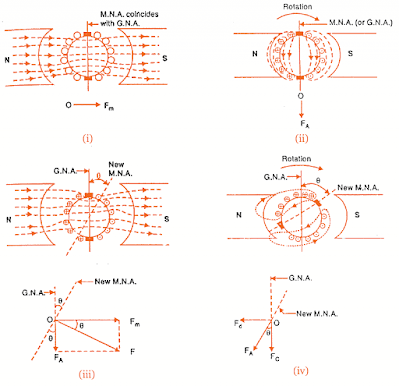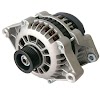Armature Reaction:
The effect of magnetic field set up by the armature current on the distribution of the flux under main poles in known as armature reaction. The armature magnetic flux has two effects.
i) It demagnetizes or weakens the main flux
ii) It cross magneticses or distorts the main flux.
The flux distribution of a bipolar generator when it is on no-load (i.e., no current in armature conductors). For convenience, only two poles have been considered, though the following remarks hold good for multipolar generator as well. The brushes are also shown touching the armature directly, but in practice they touch commutator segments. It is seen that,
a) The flux is distributed symmetrically with respect to the polar axis, which is the line joining the centres,
b) The magnetical neural axis (G.N.A.). coincides with the geometrical neutral axis (G.N.A.).
M.N.A. is axis along which no e.m.f. is induced in the armature conductors, because they move parallel to the lines of flux. This M.N.A will be perpendicular to the flux through the armatures and is also known as axis of commutation, because the reversal of current in armature conductors takes place across this axis. The brushes are always placed along M.N.A. In
a) vector Ofm represents, main flux both in magnitude and direction, which is perpendicular to M.N.A.
B) Represents the flux set up by the armature conductors alone assuming main poles are unexcited. The current direction is downwards in conductors under N-pole (represented by dots). The direction of current can be determined by Fleming’s Right-Hand Rule. The armature flux is represented both in magnitude and direction by vector OFa which is parallel to brush Axis.
So far we have considered the main flux (or mmf) and armature flux separately as if they existed separately, which is not the case practice. Under actual load conditions, the two fluxes exists simulataneously in a generator as show in fig.
It can be observated that the flux throught the armature is no longer uniform about polar axis, rather it has been distorted. The flux is crowded at trailing pole tips and weakened at leading pole tips as shown in fig. The resultant flux OFr is found by vectorially combining the Ofm and OFm and OFa The position of M.N.A. is shifted by sn angle q, which is perpendicular to OFr, brushes are also shifted so as to lie on new M.N.A. Due to this brush shift (forward lead) The armature conductors which were under the influence of N-pole will come under the influence of S-Pole and Vice-versa.
Phenomeno of
Demagnetisation And cross-magnetization:
All the conductors above and below the new M.N.A. Carry the current downward and upload respectively. The armature flux is now represented by the vector OFa which is not vertical as earlier, but is inclined at an angle 0 as show fig. This OFa can be resolved in to two components OFc Perpendicular to polar axis, and OFd parallel to polar axis. We can conclude that
i) Component OFd is in Direct opposition to vector OFm. It exerts demagnetizing influence on the main flux. Hence it is called the demagnetizing or weakening component of the armature reaction.
ii) Component OFc is at right angles to the vector OFm. It produces distortion in the main field and know as cross-magnetising or distorting component of the armature reaction.
It should be noted that both demagnetizing and cross-magnetising effects will increase with increase in armature current.













0 Comments